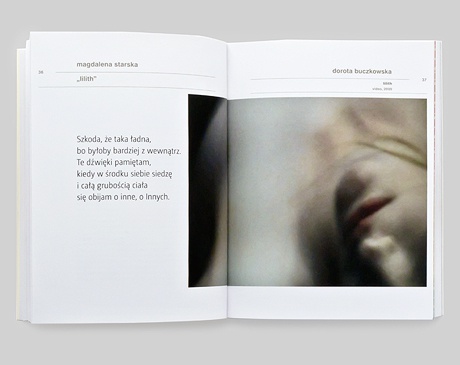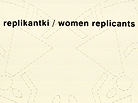‘Women Replicants’ summary book of the cycle of exhibitions

year of publication: 2010
size: 16,2 x 21,6 cm
volume: 144 pages
edition: 500 pieces
binding: softcover
reproductions in colour
languages: Polish/English
graphic design and typesetting: Katarzyna Goczoł, Magdalena Piwkowska
publisher: BWA Contemporary Art Gallery in Katowice
ISBN 978-83-88254-60-4
Contents:
Marta Lisok
Marta Kudelska ‘a woman replicant’
callousness
Marta Lisok ‘callousness’
Katarzyna Czeczot ‘skin of an interrorist’
Katarzyna Czeczot ‘with whom is lilith dancing?’
Dorota Buczkowska — work
Magdalena Starska ‘lilith’
Magdalena Starska ‘taming’
Dorota Buczkowska — work
Magdalena Starska ‘interror’
Agnieszka Dąbrowska ‘stone’
greenhouse conditions
Marta Lisok ‘greenhouse conditions’
Kinga Bella ‘intimate places’
Kinga Bella — works
Zuzanna Sokołowska ‘rapunzel syndrome’
Agnieszka Kwiecień talks with Natalia Bażowska on creation
Natalia Bażowska — works
Magdalena Starska — works
Tatiana Wolska — works
minimal corrections
Marta Lisok ‘minimal corrections’
Dominika Skutnik ‘a necklace set with gravel’
Alicja Karska & Aleksandra Went — works
language as a licking tool
Marta Lisok ‘language as a licking tool’
Justyna Gruszczyk ‘warm smell of the monster’
Bianka Rolando ‘pretty woman; a notice’
Bianka Rolando — works
biographies
Price: 11 zł (about 3 euro)
Visit our bookshop or order by e-mail:
ksiegarnia@bwa.katowice.pl

women replicants (4) — language as a licking tool — Justyna Gruszczyk and Bianka Rolando In his legendary action How to Explain Pictures to a Dead Hare? Joseph Beuys is whispering something in the ear of a dead hare carried in his arms....

women replicants (3) — minimal corrections — Alicja Karska and Aleksandra Went Works by Aleksandra Went and Alicja Karska seem to be resistant and tightly closed in their simplicity. Just like in the case of dreams about which we...

women replicants (2) — greenhouse conditions — Natalia Bażowska, Kinga Bella, Magdalena Starska, Tatiana Wolska Apart from precise tools, delving into author’s visions requires patience and attention; the reading on the run is losing sense. Ideal work conditions...

women replicants (1) — callousness — Dorota Buczkowska ‘Lilith’, ‘Interror’, … Callousness abolishes consciousness, pain and defensive reflexes. As an operation it results from the need of stiffening and protection from too intense...

This book has been planned as a documentation of an exhibition cycle which was staged at the BWA Contemporary Art Gallery in Katowice in 2010. The works of the artists who are related to the Academy of Fine Arts in Katowice, Kinga Bella and Natalia Bażowska, are presented alongside some most renowned and highly regarded Polish contemporary artists, including Dorota Buczkowska, Alicja Karska, Aleksandra Went, Bianka Rolando and Magdalena Starska.
The ‘Women Replicants’ project was based on the trust in intimate messages and the collection of exuvia left over by the artists as they were selecting the topic of their work and its narrative structure. The gender factors involved in the concept of this project have a historical background. Confining women to domestic environs, stemming from the centuries-old practice of limiting them to the private sphere, sharpened their senses and increased sensitivity. The rhythm of household duties, which was not tuned to the linear view of time, neither conveyed a scheme nor proved existence. This innate repetitiveness was contrasted with a treacherous and harsh exterior. In the circumstances, the artists' affectionate transcription of reality acts as a personal therapy. In this context, their descriptions and stories constitute an attempt at overcoming invisibility and irrelevance.
The cycle's title is a perverse reference to cyborgs, creatures which are supposed to play a secondary role towards the inventor. They are programmed to be passive, yet at the same time allowed to get out of control. The term replica women carries a revolutionary potential and threatens to turn its back on the system which has created them. In the case of these particular artists, ingratitude towards reality consists of magnifying it, depriving it of stability, and liquefying it.
The colour of the cover alludes to skin colour and emphasises a frequently recurring physical aspect of the works featured within the framework of ‘Replica Women’. Its surface is covered with a cut out design presenting schematic figures of girls holding hands. This refers to shared experience, in this case each artist's mode of work, which is based on an affectionate observation of their surroundings. The reader can gently tear out a selected part of the cover along the dotted lines and thus create their own openwork design, like lace. This is related to the tactile potential corresponding with the traditional division of social roles, whereby a woman has for centuries been assigned to the private sphere, associated with needlework, child care, and the hustle and bustle of home. Apart from the pictures of individual realisations assigned to the four stages of the cycle (entitled, in the following order: Callousness, Greenhouse Conditions, Minimal Corrections, The Language as a Licking Tool), the book contains critical and philosophical articles, interviews, short stories and poems, which broaden the readers' range of reception of the presented works.
Each part with texts and illustrations is separated from the others with colour pages — references to the motifs used in the promotional posters for the subsequent stages of the cycle. They are covered with ornamental designs, which are based on the pattern from the cover, and which combine the topics appearing in individual stages. As a result, the book takes on the form of a notebook, perhaps even an old-fashioned commonplace book. The diary style adopted by the authors reveals the intimate nature of messages in the presented works. The contributing artists, who make visual attempts at relating their own experience, do not present the recipients with an easy task. The audience is not allowed to stay out of the story, which could easily fall to pieces if not handled with care.
The concept of the cycle was based on the premise that the external blends with the internal. The process of the reception of the presented works resembles yeast in motion, swelling when left in favourable conditions. Its surface cracks, stratifies and fills with air. It becomes soft and tender. Some parts seem transparent, while others turn into lumps. Yeast reaches the rim of the dish and overflows.
The open form of these works and texts requires the audience to devote some of their time, as a form of compensation for the authors' patient observation, in absorbing and processing the content. These works call for interpretative effort and attention. From this perspective, the reading process is governed by the law of individual engagement, in which the receiver puts his or her own subjectivity on the line. The works allow the audience to melt in the oversensitivity of the authors, whose artworks, like secrets, bring about a threat from the things which are familiar — carnal and domestic — yet unknown and strange. As Herta Müller says: ‘In the system, in which everything is forbidden, it is sensuality that poses a great danger. It is all due to it being as unpredictable as imagination. These spheres are out of control.’







